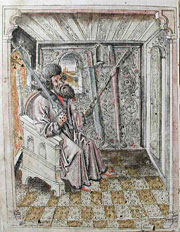The handling of weapons was part of the training and education of young nobles in the middle ages and the early modern times. Citizens were tasked with defense duties had to practice their skills as well.
The spectrum ranges from simple unarmed wrestling, sword fencing to mounted combat on horses. There are differences between mounted combat on horse and duels on foot, as well as differences between armored and unarmored fencing.
The Historical Sources: Fencing Manuals
For a long time, skills, especially manual skills, have been passed on orally. Luckily for us, with the beginning of the 14th century, people started to write down knowledge about fencing and fighting. These manuals are the foundation of the historical martial arts we are practicing today.
But it isn’t that easy: many texts are in early high modern german and written by hand. Oftentimes, we only have incomplete sources with only text or only pictures. Thus, the sources have to be transcribed to our script and language. An interpretation has to be made of a transcription, which has to be tested in training with sword in hand for plausibility.
Many fencing manuals can be found on our website. Have a look at the sections Transcriptions, fencing manuals or publications by Hammaborg members.
The Tradition of Liechtenauer
Johannes Liechtenauer was a fencing master who lived and taught in the 14th century. Unfortunately, further biographical details do not exist. The first notion of his teachings can be found in the manuscript 3227a, dated 1389. The manuscript is in the possession of the Germanisches Nationalmuseum in Nuremberg and is often called the “Hanko Döbringer Hausbuch”. Liechtenauer’s influence was so tremendous that even in 1570 Joachim Meyer referred to him in his expansive fighting manual “Gründtliche Beschreibung der kunst des Fechtens”.
Only very few fechtbücher with commentaries on Liechtenauer’s teachings have survived the centuries. Among the better known ones are the manuscripts allegedly written by Sigmund Ringeck, Hans von Speyer and codex 44 A 8, formerly ascribed to Peter von Danzig, dating from between 1440 and 1492. Our interpretation is mostly based on transcriptions of the longsword sections of these manuscripts.
A translation into modern German of the manuscript 44 A 8 can be found here.





